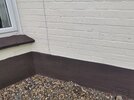- Joined
- 9 Apr 2015
- Messages
- 30
- Reaction score
- 0
- Country

Hi all,
We're about to have our sitting room wall treated for rising damp.
From doorway in hall, to window bay in sitting room.
The builder has sent an FAQ that states that, once they've finished, that we can apply some paint 4-weeks after, but shouldn't decorate for at least a year.
Is this correct?
We were looking to put the house up for sale in January.
We're about to have our sitting room wall treated for rising damp.
From doorway in hall, to window bay in sitting room.
The builder has sent an FAQ that states that, once they've finished, that we can apply some paint 4-weeks after, but shouldn't decorate for at least a year.
Is this correct?
We were looking to put the house up for sale in January.



